Comuna 13 is known for its street art – but there’s a lot more to this neighbourhood than pretty murals and selfie spots. Here’s everything you should know before taking a Comuna 13 tour in Medellin, Colombia based on my personal experience.
Just a few short years ago, Comuna 13 was considered the most dangerous area in Medellin, itself the most dangerous city in the world.
Tourists didn’t dare set foot here – they had no reason to. And many locals, as our Comuna 13 tour guide Laura told us, were too ashamed to admit that they lived in the ramshackle suburbs that cling to a mountainside on Medellin’s western fringe.
Now, it’s a very different story. Over the past decade Comuna 13 has undergone an almost complete transformation – or so it seems.

The area is no longer known for gang violence, police raids, cartels and illegal trafficking.
These days, Comuna 13 is more readily associated with graffiti, street art performances and walking tours. New infrastructure, including a cable car system and six outdoor escalators, has made life in Comuna 13 a whole lot easier for residents and opened the area up to tourists like never before.
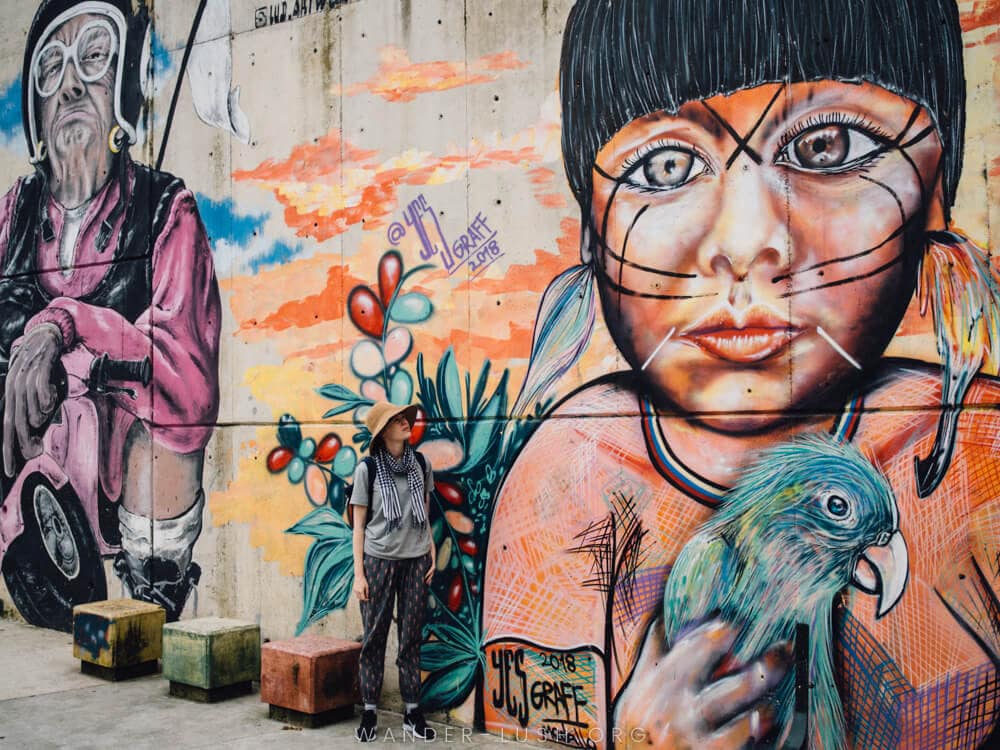
Many people view Comuna 13 as a symbol of Medellin’s (and indeed Colombia’s) social transformation. It’s one of the most vibrant and intriguing places we visited in Medellin and a must-see, even if you only have a couple of days in the city.
However, there are still a lot of misconceptions surrounding Comuna 13, especially regarding safety. Part of the joy of visiting is discovering these contrasts and contradictions for yourself. But there are a few things I wish I had known before we signed up for our Comuna 13 tour.
Here are 13 things I think you should consider before you go, plus my recommended Comuna 13 walking tour itineraries.
Please note: This post contains affiliate links, meaning I may earn a commission if you make a purchase by clicking a link (at no extra cost to you). Learn more.
Recommended Comuna 13 Tours
Option 1: 4-hour graffiti tour with a local guide – This top-rated tour includes metro tickets, snacks, and invaluable insights from a local guide. Two departures daily in the morning and afternoon. Prices start from $25. (Also available to book here on Viator.)
Option 2: Private Comuna 13 tour with hotel pick up – An in-depth Comuna 13 tour tailored to your interests. Flexible start time and hotel transfers included (great for families, solo travellers or groups). Prices start from $37.\
Option 3: Full-day city tour with cablecar and Comuna 13 walking tour – Longer walking tour (5+ hours) that shows you the best of Medellin downtown as well as Comuna 13. If you only have a day in Medellin, this is a great option. Prices start from $46.
Option 4: Social Transformation Tour – This walking tour with hotel pickup focuses on the neighbourhood’s history to give you an in-depth understanding of Comuna 13. I have personally travelled with Steven, the company operator and main guide, and was extremely impressed with his knowledge and attention to detail. Prices start from $61.
Option 5: Comuna 13 Graffiti Tour and Street Food Tour – The ultimate combination of street art and street food for a comprehensive introduction to all aspects of local culture. Includes empanadas and ice cream.
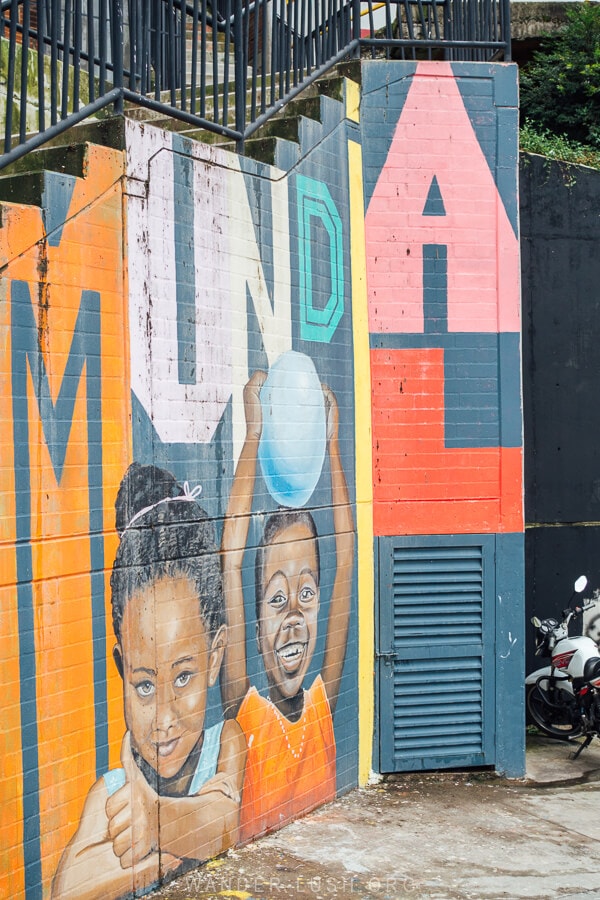
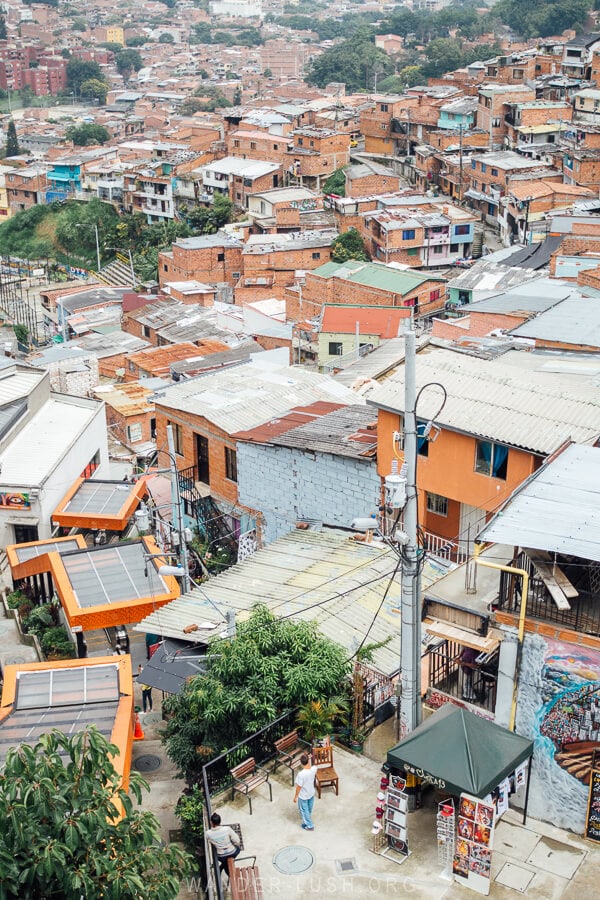
Before you go…
If you’re planning to visit Medellin and you want to learn a bit about Comuna 13 and Colombian culture before you go, why not try a virtual travel experience where you can meet and chat to a local.
This Airbnb Online Experience with a local takes you through the basics of Colombian history and culture – it’s the perfect way to prepare for your trip!
What is Comuna 13? A very brief history of Medellin’s most notorious neighbourhood
One of the most important things you can do before visiting Comuna 13 is take the time to read a bit of background information. You’ll learn lots on the tour, but it helps to have a general understanding of the area and its turbulent past.
Comuna 13 started out as an illegal settlement. In the 1960s and 70s, around 1,500 families displaced by conflict in different parts of Antioquia Department settled here. The neighbourhood was unplanned: They built their houses from basic materials, and there was no running water or electricity.
Comuna 13 rose to notoriety in the 1980s and 1990s at the height of Colombia’s drug and gang era. Because of its location on the edge of the city and the way its organised (winding streets and an awful lot of places to hide), the barrio became a transit point for drug traffickers, guerillas, gangs, and otherwise unsavoury characters. Soon enough, paramilitary groups ELN and FARC were fighting for control of the commune.
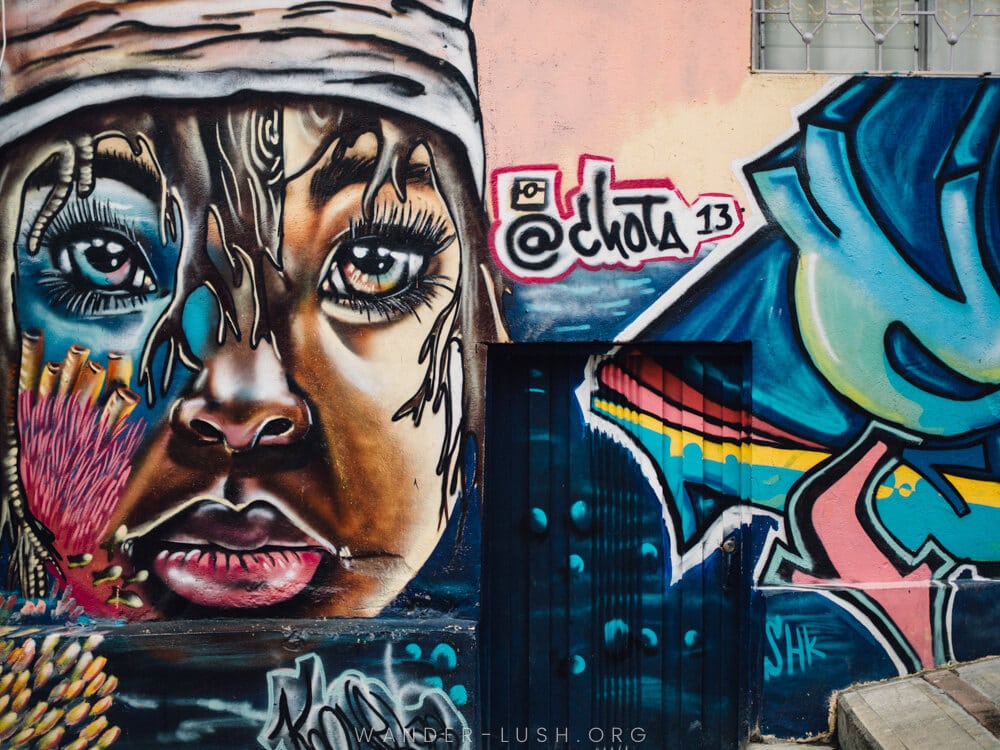
The idea to ‘clean up’ Comuna 13 started in 2002 when a newly elected President Alvaro Uribe took a heavy handed approach and launched 10 military operations. The two biggest, known as Mariscal and Orion, were designed to root out the paramilitary. As you can imagine, many residents – regular working families and innocent civilians – got caught up in the fray. At least 20 people lost their lives, almost 250 were arrested, and many more simply disappeared.
In 2006, Comuna 13’s image finally started to change. Medellin Mayor Sergio Fajardo Valderrama took a different tact and set about improving living conditions for underserved families by involving them in the process. He invested massively in infrastructure, including a new metro station (2008) and outdoor escalators escaleras electricas (2011), to reintegrate the commune with the rest of the city. This approach turned out to be much more effective.
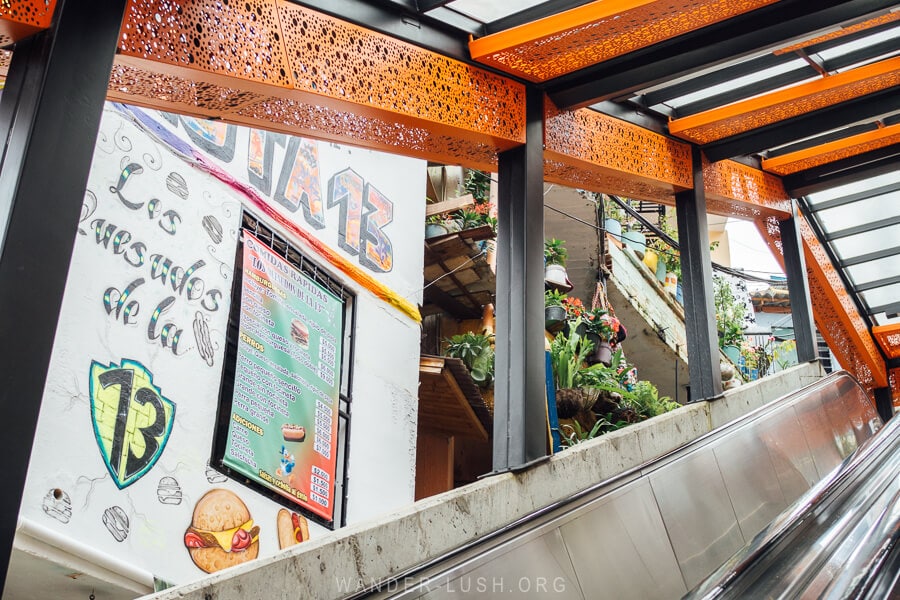
The Comuna 13 of today is a very different place. With greater accessibility came less stigma, and the narrative surrounding Comuna 13 slowly started to shift. The streets became safer, and the neighbourhood was once again a playground for children and artists alike. Now responsible tourism is a major contributor to social change in the barrios.
When you visit Comuna 13, you can witness this incredible transformation up close. No one has forgotten the past, but everyone is looking towards a brighter future. It really is a remarkable story and a special place.
13 things to know before signing up for a Comuna 13 tour
1. It’s not a place for dark tourism or ‘narco tourism’
Colombia’s own brand of dark tourism, ‘narco tourism’, is a thriving industry in Medellin. What many partakers don’t realise is just how offensive many locals find it. If you want to do paintball at one of Pablo Escobar’s former residences, then be my guest. I’m not here to judge.
But Comuna 13 is not the place to gawk at the horrors of the past.
Transformation, rebirth and hope are themes that come up again and again in Comuna 13. These are the things your guide will focus on, not the violence of the 80s and 90s.
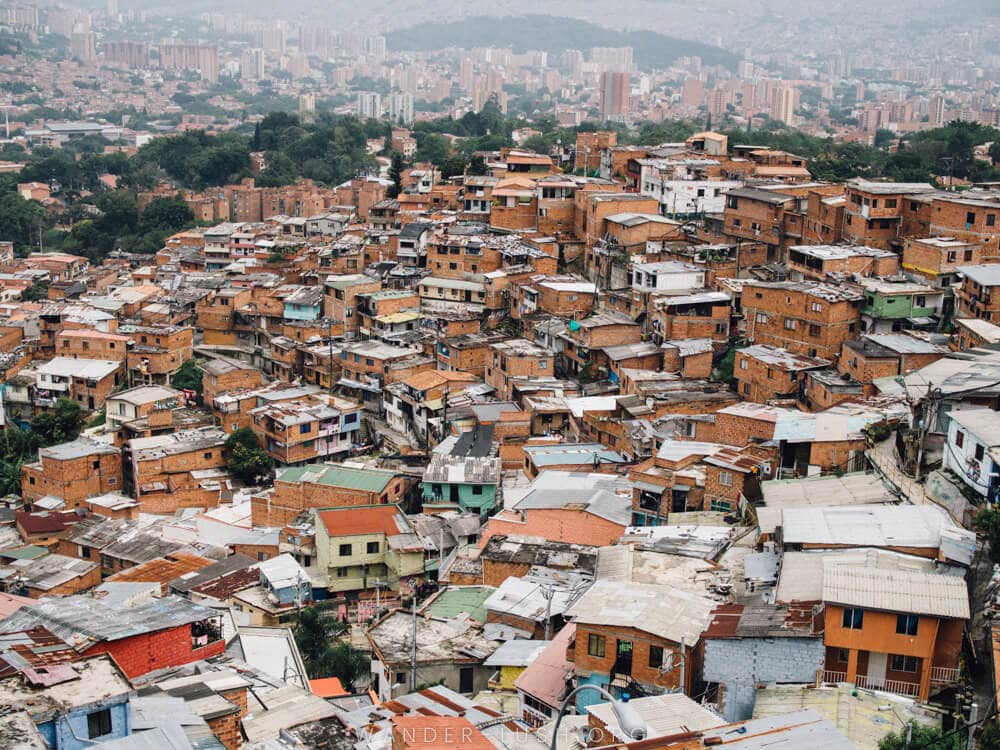
Comuna 13 has undergone a massive physical transformation in recent years, as documented in memoirs like this one. But what’s even more important than the aesthetic changes is shifting the way people think about the area. And that has involved a transformation of the psyche.
There are countless books about Colombia (fiction and non-fiction) that can give you a deeper insight into this chapter of national history before you arrive in Medellin. But the best way to learn is to experience it on the ground.
Most people in Comuna 13 (and Medellin) choose to look forward, not back. Memories of past violence are still very raw for families in this area, with many thousands of people still unaccounted for.
Bottom line: Be respectful and sensitive, and please leave your Pablo Escobar t-shirt at home.
2. Comuna 13 isn’t one neighbourhood
There’s a common misconception that Comuna 13 is one discrete barrio. In truth, it’s a commune (one of 16 in Medellin) that incorporates around 12 separate neighbourhoods spanning more than 2 square miles.
The name ‘Comuna’ does not only refer to the low socio-economic hilltop barrios around the city, either. El Poblado and Laureles are comunas too. El Centro, for example, is a district within Comuna 10.
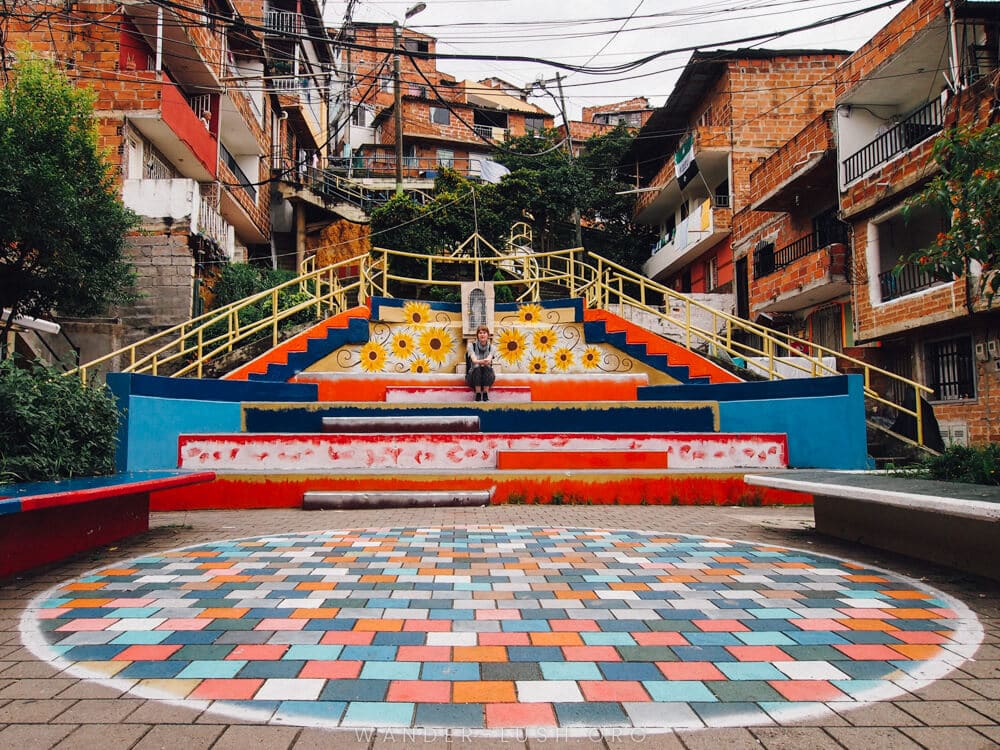
It’s important to understand that Comuna 13 is huge. Some areas are safe for tourists to visit, while other barrios should be avoided. Most walking tours focus on the Las Independencias and 20 de Julio area, where most of Comuna 13’s street art is located.
Because of the size and layout, it’s very easy to get disorientated in Comuna’s 13’s labyrinth of narrow laneways and private entries – that’s another reason why it’s a good idea to visit with a guide.
3. A Comuna 13 tour involves a lot of walking (and stairs)
Most tour companies instruct you to wear comfortable shoes when you book a tour. But I wasn’t prepared for just how much uphill slug is involved in visiting Comuna 13. Just getting to the street art area from the metro station takes a good 15 minutes of walking up a steady incline.
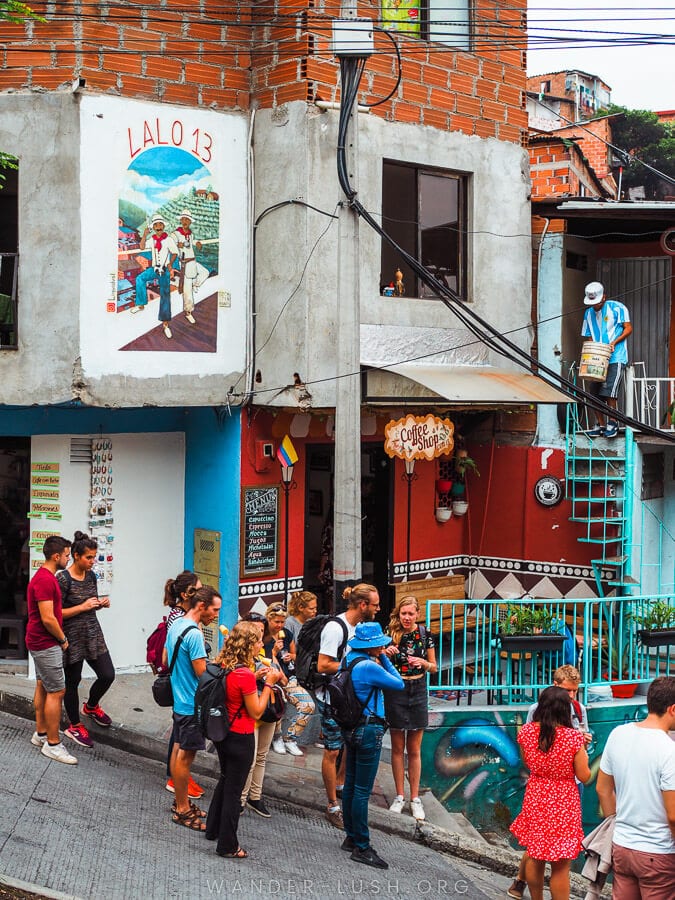
Comuna 13 is set on a steep hillside, so stairs are an unavoidable reality. Comfy, lightweight shoes are essential, as is plenty of drinking water, sunscreen, and a good hat or an umbrella. Just be glad you don’t have to carry your groceries or push a stroller!
The saving grace are the six interlacing outdoor escalators that replace 350 of the steepest stairs. Free to ride, they operate from the early morning until late at night and will always be running in the daylight hours when tours take place (including on Sundays and holidays).
Once you reach the top of the escalators, the terrain evens out a little. This is where you’ll find wide concrete pedestrianised areas (like the one in the first picture above) that feature seating and lighting.
4. It’s better to go with a local
There are dozens of companies in Medellin that offer tours of Comuna 13. As more and more people visit, the commercialisation of the community’s grief is becoming a serious issue. It’s something you should keep in mind when booking a Comuna 13 tour.
The most responsible and ethical option is to go with a local guide. Zippy Tour guides, for example, all grew up in Comuna 13 and know the streets (and the stories) well.
They incorporate personal anecdotes and authentic accounts without dramatising or romanticising things. And in our experience, they are truly grateful for the chance to show tourists around their barrios.
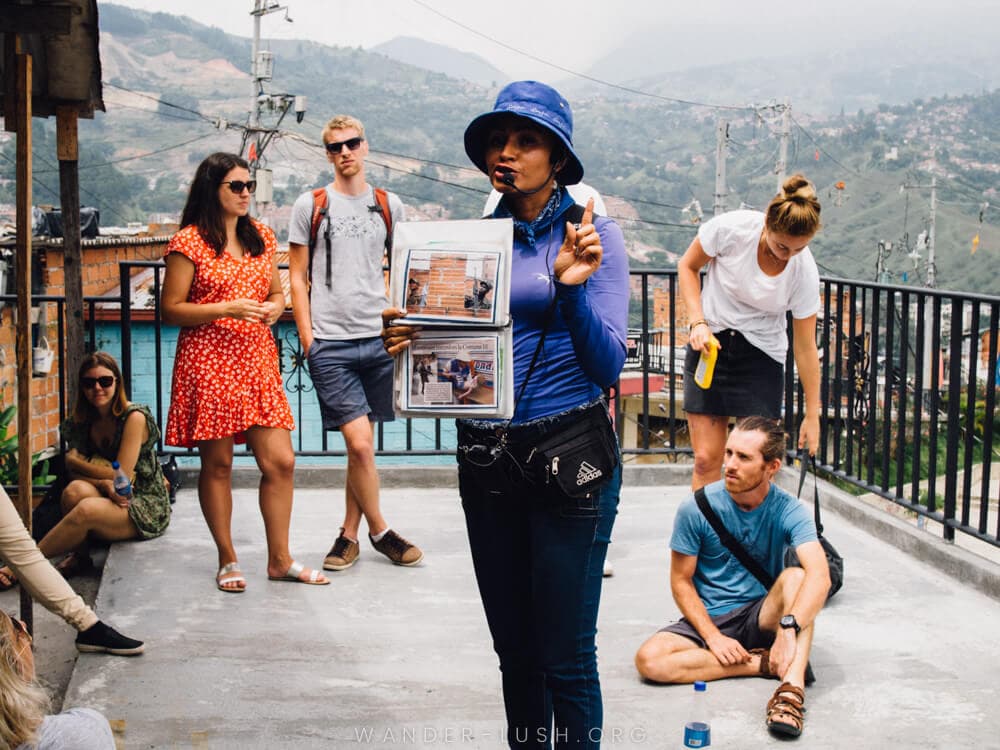
Our guide, Laura, taught herself English so that she could show visitors around the streets she grew up on.
The photo above was taken on the balcony of her family home – how many walking tours do you know of that make a stop at the guide’s house!? That’s just how generous and open the local guides can be.
5. It feels a lot safer than you might expect…
I can only speak to our experience, but we felt completely safe in Comuna 13 – both when we were with our guide and at the end of the day when we were walking back to the Metrocable alone.
Exercise common sense and caution as you would anywhere else. But don’t let fear or hearsay stop you from visiting Colombia or Comuna 13.
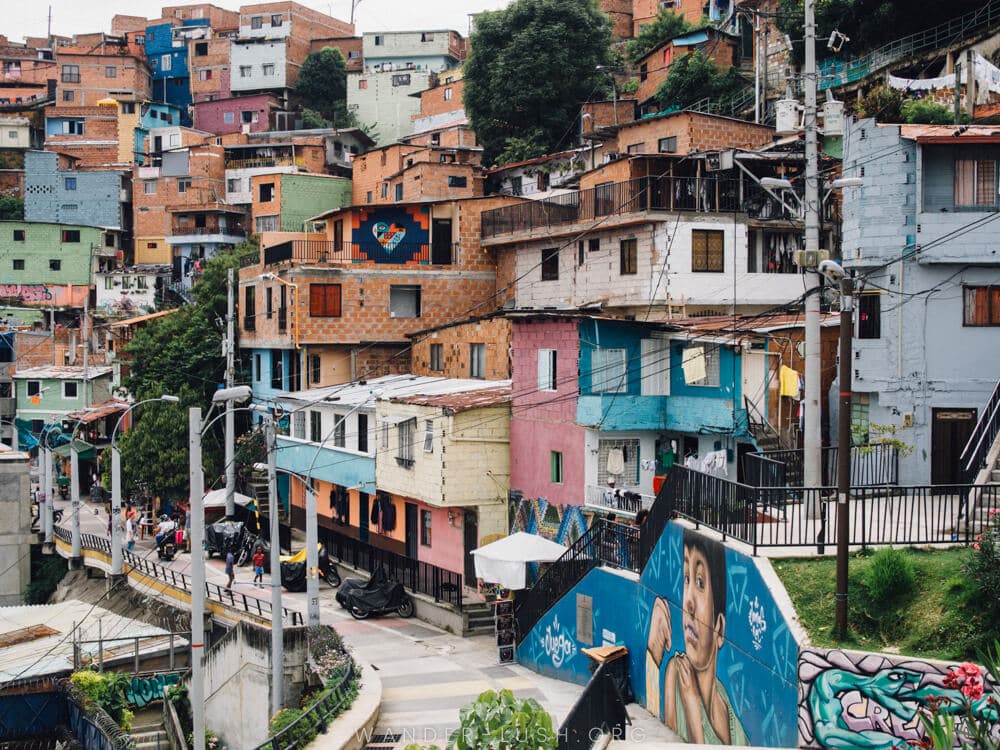
Remember that it’s easy to get lost, so stick close to your guide and don’t wander off track. At the end of the tour you may have the option to walk yourself back to the metro station, in which case your guide will provide directions.
If you prefer to stay with a guide at all times, choose a tour itinerary that includes transfers back to downtown, either by bus or Metrocable.
6. …But that doesn’t mean there’s no crime or violence
Comuna 13 has changed a lot, but poverty and violence are still big issues here. We were told that a few weeks before our visit, another tour group had to take cover from gunfire after fighting broke out between rival gangs.
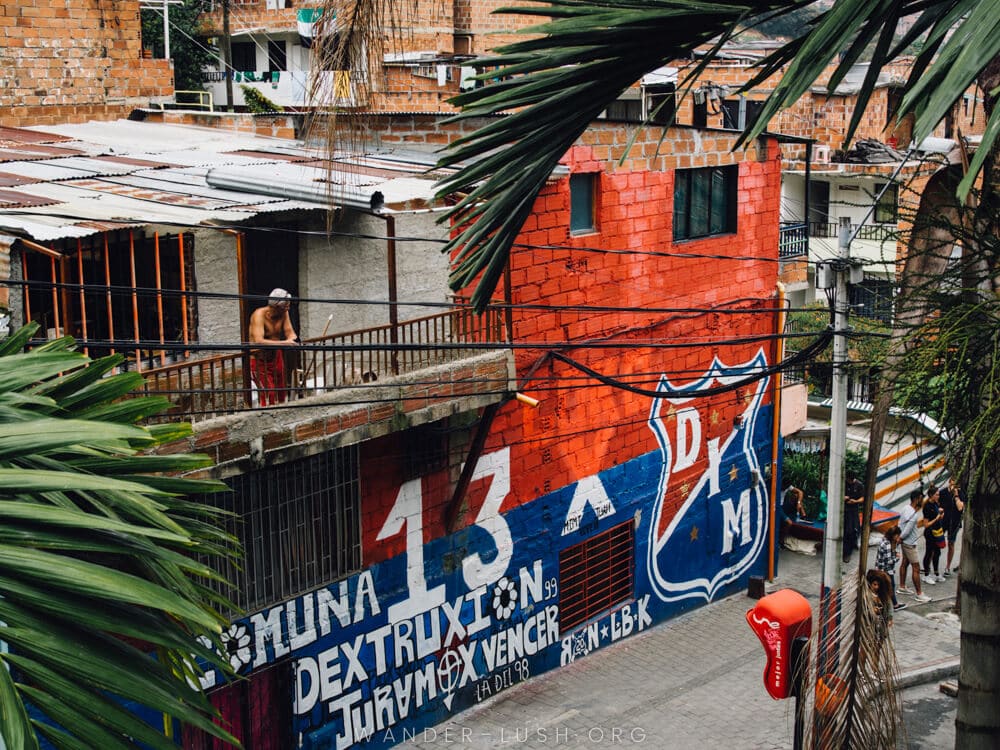
It’s perfectly safe to visit Comuna 13 during daylight hours. But just like the rest of Medellin, it’s not recommended to walk around after dark.
7. The locals are extremely welcoming
I get the feeling that foreign tourists are still a bit of a novelty in Comuna 13. We were warmly greeted everywhere we went in Medellin, but the smiles and buenoses we received in this part of the city were more animated and generous than anywhere else.
After our Comuna 13 tour ended at the top of the escalators, we decided to walk ourselves back to the metro instead of riding the bus with our guide.
It was interesting to see how people’s reactions toward us changed once we were no longer travelling with a group. It felt like people were even kinder to us than before.
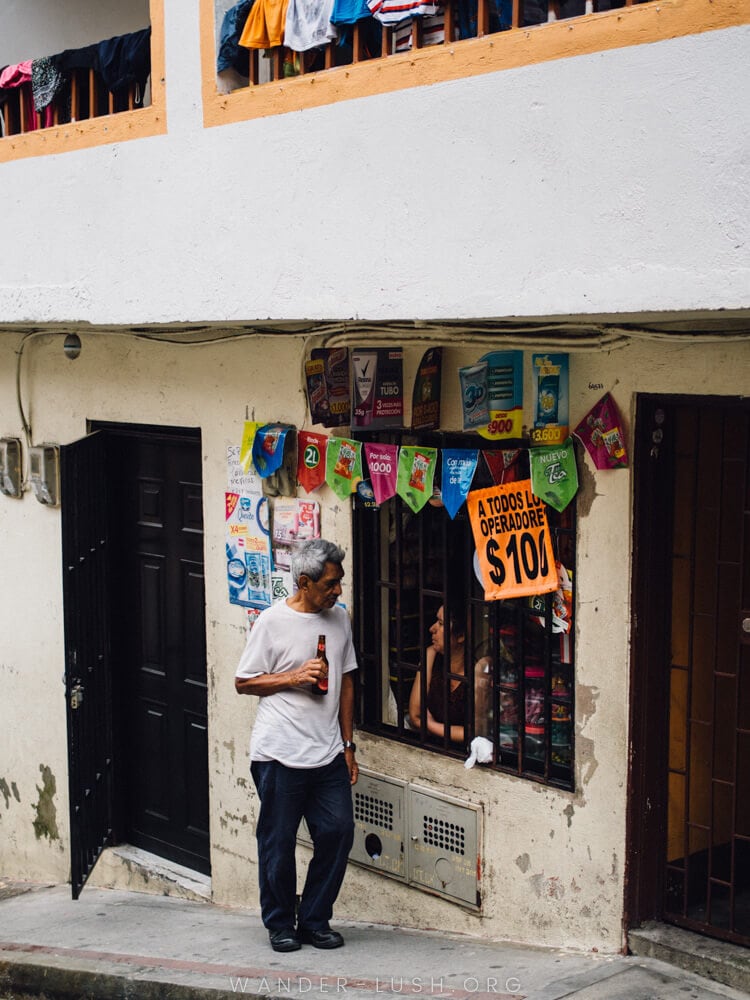
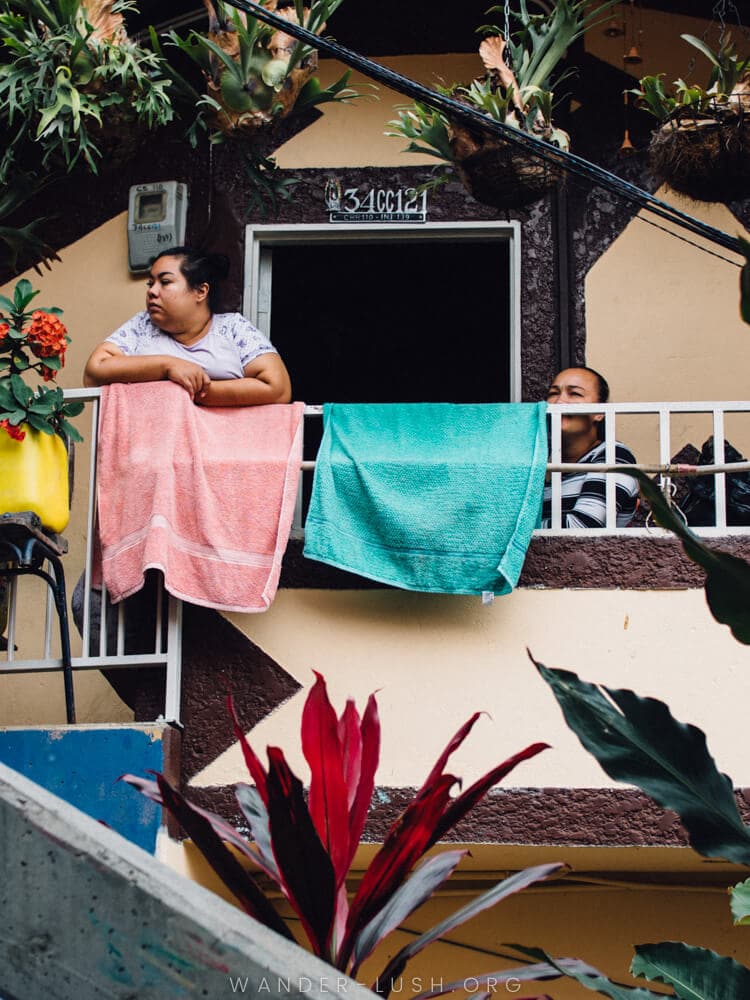
Like in any residential area, most people in Comuna 13 are just going about their daily business. Be respectful of people’s privacy (especially of accidentally trespassing) and use common courtesy when taking photos.
8. There are plenty of places to eat, drink and shop for souvenirs
We passed by dozens of restaurants, cafes, coffee shops and bars during our Comuna 13 tour. There is a large concentration of local eateries around the San Javier Metro Station, while plenty of ‘tourist-friendly’ venues (with English menus and clean bathrooms) have opened up around the street art zone. If you like ice cream, there are a few places that sell popsicles!
There are also several small galleries and market stalls dotted along the main pedestrian route where you can buy art prints and other souvenirs.
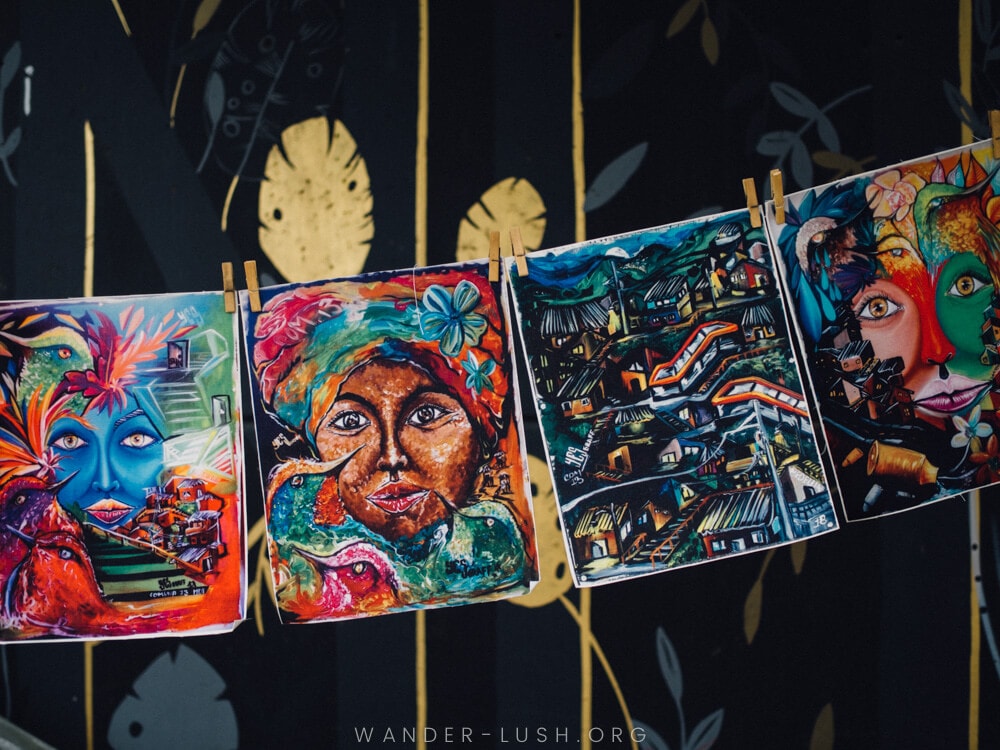
I expect that many more venues will open up as Comuna 13 continues to grow in popularity.
Note that most tours include a stop off at at least one cafe or restaurant.
Tip: Did you know that there is a district in Bogota that’s similar to Medellin’s Comuna 13? If you’re visiting Colombia’s capital, why not join a Social Transformation Tour of Barrio Egipto.
9. The street art in Comuna 13 is not just for decoration
You don’t need me to tell you that Comuna 13 is all about the street art. Not only does it look fantastic and form a perfect backdrop for tourist selfies (guilty as charged!), the murals are also symbolic.
There are dozens and dozens of large-scale works throughout the area, manly concentrated around the escalators. Any and every surface can be used as a canvas.
As our guide Laura explained to us, graffiti is actually illegal in Medellin. For a local artist to create a mural, they first need to obtain permission from the area’s chief artists as well as the owner of the building.
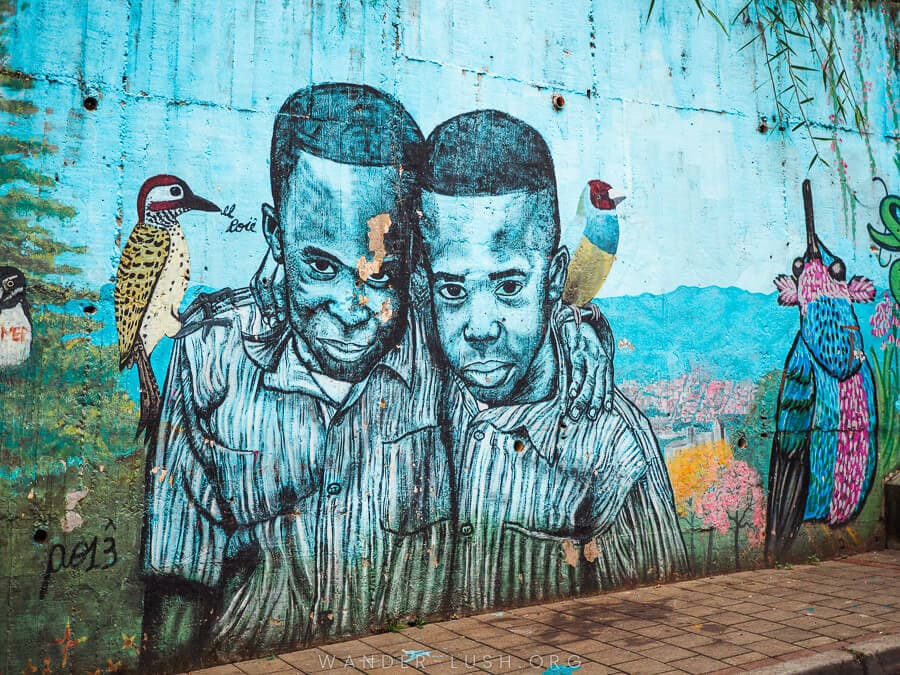
Murals in Comuna 13 definitely aren’t just for decoration: They also serve to memorialise the past and express hope for the future.
Your Comuna 13 tour guide will point out the best pieces. Special motifs to look out for include white cloths (a reference to May 2002, when a mother flew a white sheets from her rooftop as a request for ceasefire after two of her sons were injured by gunfire; anything in red, yellow and blue (the colours of the Colombian flag and a stand-in for national pride); and birds (another symbol for peace).
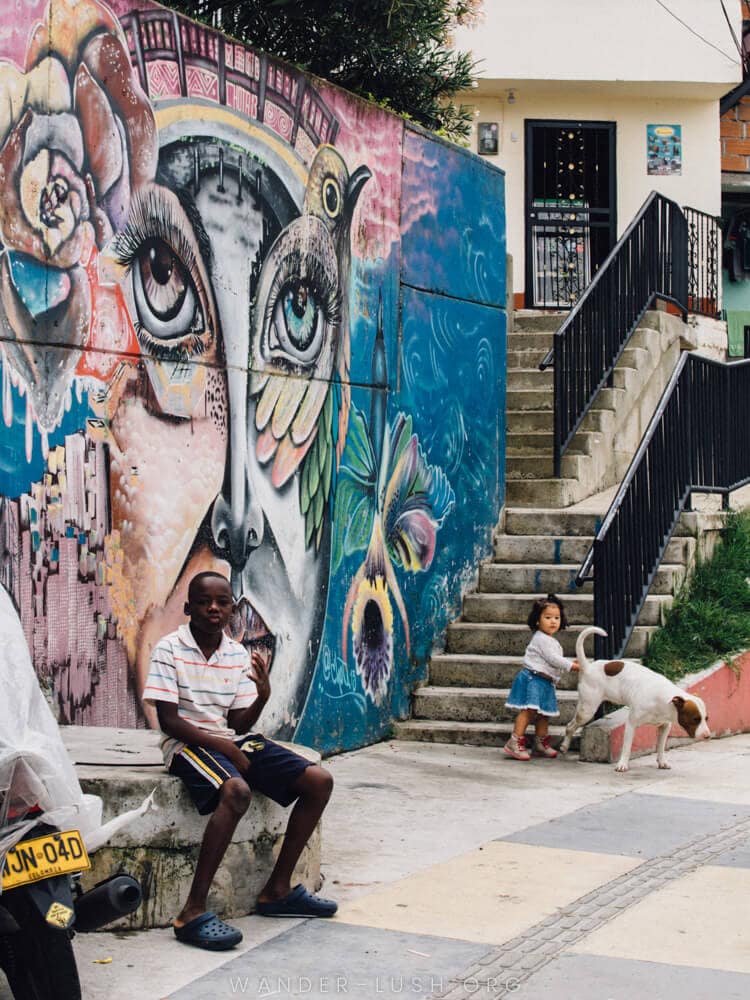

My favourite symbol in Comuna 13 is elephants, which represent the barrios’ pledge to never forget the events of the past.
Many families have painted their houses in bright colours to match the murals, making the whole area feel vibrant and uplifting.
10. There are other kinds of art to look out for, too
There are plenty of other art forms visitors should keep an eye out for, including performance art, music and breakdancing.
During our tour, we watched a short performance by Black and White, a local hip-hop crew.
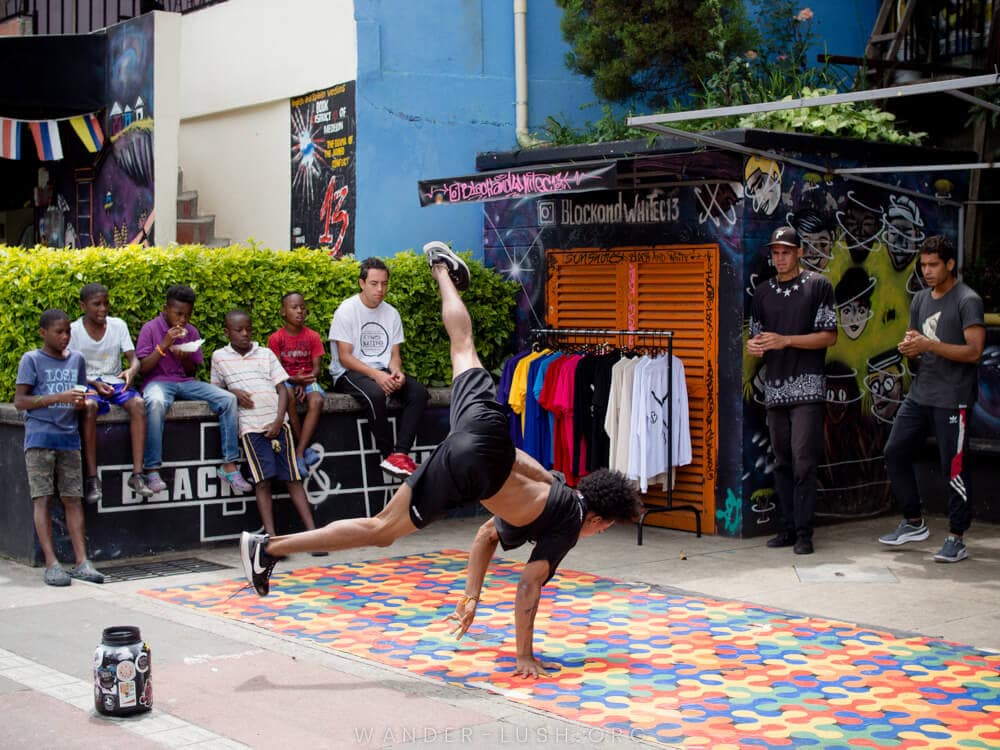
Another group you might encounter is C15 Collective, a coalition of young graffiti artists, music producers, rappers, photographers and DJs from Comuna 13.
They oversee up to 90% of the street art in the area and run a physical exhibition and performance space, Casa Kolacho, where people can come together to collaborate and develop new art forms.
All these different artistic formats – some organised by community leaders, some organic and self-managed – are designed to provide an alternative pathway for youth in Comuna 13.
11. You should visit Casa de la Memoria first
For a better understanding of Comuna 13’s art scene and how creatives grapple with sensitive and raw topics, I highly recommend visiting Medellin’s Museo Casa de la Memoria (Memory House Museum) near Parque Bicentenario first.
My main takeaway from the museum was that art is used to interpret and make sense of past events, which often means it’s quite abstract.
Our visit to the museum gave us a bit of background knowledge and prepared us for our Comuna 13 tour. Even if you decide against visiting Comuna 13, Museo Casa de la Memoria is a must-visit in Medellin.
12. Comuna 13 offers some of the best views of Medellin
It’s not exactly difficult to get a good view in hilly Medellin, but I was surprised by the vistas from Comuna 13. This area is high, and in my opinion offers the best outlook over the city.
From Comuna 13, you get an appreciation for the scale of the city. The viewpoint also allow you to look down over the colourful rooftops and beyond to the green hills that form the city’s western border.

The views get better with each escalator you ride or set of stairs you climb, so persevere! There are lookout points with handrails dotted all along the way where you can stop for photos.
13. By visiting, you’re helping a community rebuild
Every family in Comuna 13 has been negatively impacted by violence in some way. By taking a Comuna 13 tour, you’re not only supporting local guides and local businesses in financial terms, you’re also helping people shed the stigma.
It’s just one of the ways responsible tourism is contributing to social transformation in Colombia.
Our guide, Laura, was very honest in telling us that families from Comuna 13 were openly discriminated against in the past. Hence why many people didn’t want to admit they lived here.
That reputation is changing with every tourist group that visits, and now young people like Laura are proud, not ashamed, to call Comuna 13 home.

If you do decided to visit Comuna 13 and like us you have a positive experience, review your guide, spread the word back home, and encourage others to go, too.
I can guarantee you that your Comuna 13 experience will stay with you long after you’ve left Medellin.
How do you get to Comuna 13 from El Poblado?
Comuna 13 is located on the western side of Medellin, about 6 miles (10 km) northwest of El Poblado. The closest metro station is Estación San Javier, the final stop on the east-west metro Line B.
To get to San Javier from Poblado Metro Station, first take Line A (red line) in the direction of Niquia to Antonio Station (4 stops in total). Here, you’ll need to change to Line B and ride it all the way to the final station, San Javier.
From the station, you need to walk approximately 20-30 minutes uphill to reach the escalators and the heart of the street art zone.
Alternatively, you can take bus 225i the rest of the way (recommended). To find the bus, turn right after the metro station exit and look for the green bus stop at the traffic lights. The fare is 1500 COP payable with the same metro card (the transfer is free if you’ve just alighted the metro).
A taxi costs approximately 10,000 COP or a little less if you use an app such as Uber.
Most Comuna 13 group tours meet at the San Javier Metro Station so you don’t have to worry about finding the bus or making your own way up the hill – just rendezvous with your guide and they will show you the way.

What time should I go to Comuna 13?
The best time to visit Comuna 13 is in the morning. There are two reasons for this: Firstly, the area tends to get much more crowded in the afternoon; and secondly, if it’s overcast, it can get foggier as the day progresses.
Because of the altitude (Medellin is 1,495 metres above sea level) and the unusual micro-climate, there is often poor visibility in the city. High humidity and low clouds can make the skies look grey and obscure your views.
Most tours of Comuna 13 start at either 9am or 10am. If you’re booking a private tour and you have the option to choose your start time, I recommend picking one of the earlier timeslots.
Is it safe to go to Comuna 13?
Yes, it is safe to visit Comuna 13 provided you use common sense. Take care of your valuables (as you would anywhere in Colombia), and if you have a backpack, consider wearing it on your front.
The biggest thing to remember when visiting Comuna 13 is not to wander off-track. The streets are a bit of a maze and it’s easy to get disorientated and accidentally walk onto someone’s private property. Stick to the main walkways.
An added element of safety comes from being with a tour group and having a local guide with you. This is another reason I highly recommend signing up for a tour rather than visiting independently.
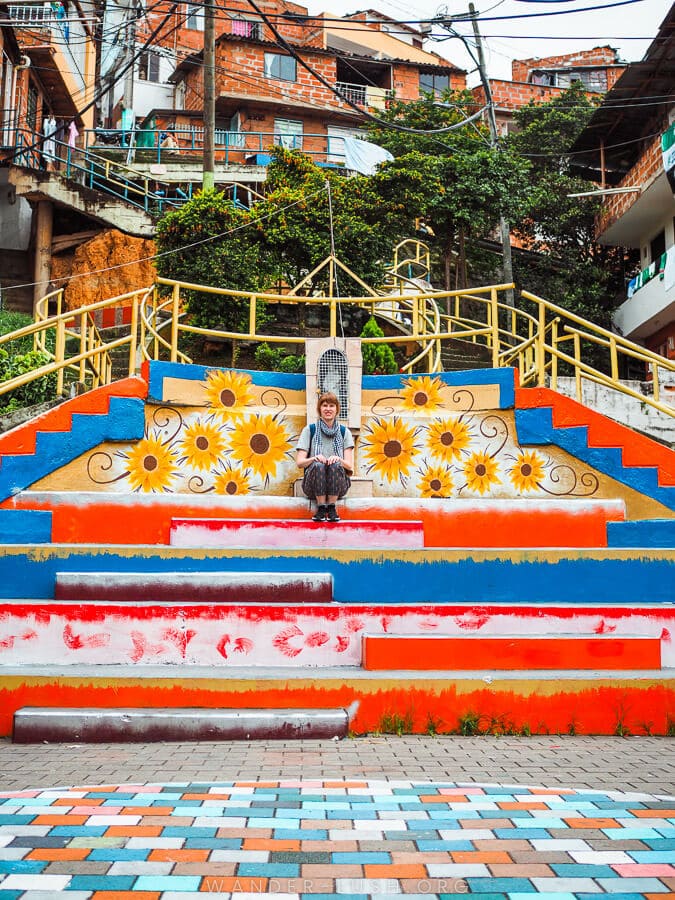
Is Comuna 13 accessible?
Comuna 13 is located on fairly difficult terrain, with lots of steep hills and streets pitched at precarious angles. As I mentioned earlier, there are a lot of stairs. Even with the escalators and cable system, it’s still fairly difficult to get around.
Not all parts of Comuna 13 are wheelchair friendly or suitable for anyone with mobility issues.
Accessible travellers can still visit the area – if that’s you, I highly recommend contacting one of the recommended tour companies below (and ideally booking a private tour) so they can plan a more appropriate route for you.
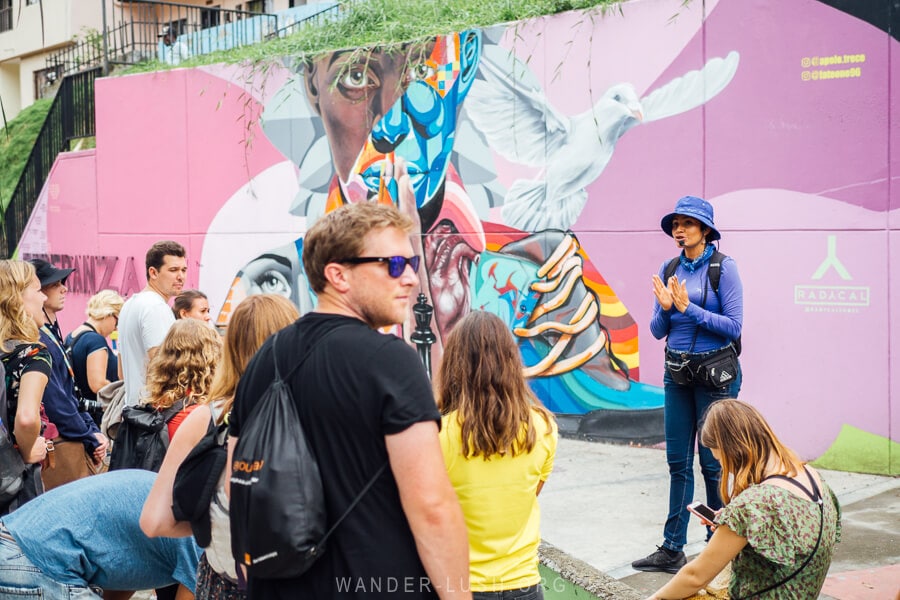
Can you go to Comuna 13 on your own?
It’s definitely possible to visit Comuna 13 independently and walk yourself around the neighbourhood. But there are several reasons why I don’t necessarily recommend it.
First and foremost, you will miss out on all the information and anecdotes you get from a guide. Meeting a local who has lived and breathed Comuna 13 for their entire life really is a huge privilege and you’ll learn so much more through this process.
Some of my best memories of visiting Medellin are of the chats we had with our guide, Laura, on the terrace of her family home. Sure, it’s possible to stop and talk to everyday people in the neighbourhood – but remember that English is not at all widely spoken, so unless you have fluent Spanish, it’s not really viable.
Secondly, as I already mentioned, it’s very easy to lose your way in the winding backstreets. If you want to go beyond the main pedestrianised roads, you’ll certainly need a guide to show you the way. Furthermore, Google Maps isn’t particularly reliable in this part of the city. While the area is generally safe, you definitely don’t want to accidentally wander into an area where you shouldn’t be.
There was one point during our tour that I almost got lost. I was taking a photo of a washing line (the one pictured just above) and when I looked up from my camera, my husband and the rest of the group had vanished. I panicked and froze, not knowing what to do. (Turns out they had gone down a nearby staircase – as soon as they popped up again on the next terrace over, I was able to rejoin them.) It was only 10 seconds or so, but it was not a good feeling to be disorientated and alone. This moment made me very grateful that I was with a guide who knew the area like the back of her hand.
An organised tour will give you peace of mind to enjoy your day fully – and I can guarantee you that you’ll come away with a much better understanding of the area and its history.
Top Comuna 13 tour companies
Comuna 13 Graffiti Tour: This company uses local guides and covers a lot of terrain over 4-plus hours of walking. The focus is firmly on the street art, making this a great tour for anyone whose primary interest is seeing he murals. The price includes metro tickets and snacks. Online bookings are available through GetYourGuide. Check prices and availability here.
Epic Tours Medellin: Another local company focused on Medellin city, Epic Tours offers a private tour of Comuna 13 with hotel transfers included. What I like about their tours is that they include other street art areas in downtown Medellin first, helping to put San Javier into context. Online bookings are available through GetYourGuide. Check prices and availability here.
Zippy Walking Tour: Free walking tours of Comuna 13 led by guides who grew up in the area. Tours are available in both Spanish and English and depart twice daily (see here for the schedule and to book). Remember to tip your guide at the end of the tour! The suggested tip is 25,000-30,000 COP per person.
Visit Medellin Tours: These popular tour programs combine Comuna 13 street art and views with a taste of local street food. Sample the best empanadas and mango ice cream during your walk around the neighbourhood – it doesn’t get more local than that. Check prices and availability here.
Lets Colombia: Steven, the freelance guide who showed us around Medellin’s fruit markets, also leads tours of Comuna 13 with his own company, Lets Colombia. Visit his Facebook page for more info.
Where to stay in Medellin
As you can probably gather from my photos of Comuna 13, Medellin is a pretty big city! It’s very spread-out, so you need to be strategic about where you base yourself. And just a heads up, you probably don’t want to stay in Comuna 13.
We spent 3 weeks in Medellin and stayed in the lovely Laureles neighbourhood. It’s leafy, it’s very walkable, there are hundreds of amazing restaurants and cafes – and it’s away from the busy downtown area, giving it a local feel. The northern part of Laureles is especially good because it’s close to the metro line.
If you prefer to be in the thick of it, El Poblado is the beating heart of Medellin. It can be a bit touristy, but on the flip side, that means lots of options for eating and drinking.
Budget hostel: The Wandering Paisa in Laureles is one of Colombia’s most-loved hostels. Choose from mixed dorms or budget-friendly private doubles.
Mid-range hotel: 574 Hotel is boutique on a budget near Lleras Park in El Poblado, with bright, tidy rooms and breakfast included.
Boutique hotel: Hotel Quinta Ladera has minimal, well-appointed rooms that will make you feel right at home in El Poblado.
High-end hotel: For an iconic Medellin experience, I highly recommend staying at Hotel Nutibara in El Centro. The 1940s Art Deco building is an architectural masterpiece.
Self-contained apartment: Factory Lofts has chic rooms with floor-to-ceiling windows and views over the beautiful Laureles neighbourhood. Choose a room with a full kitchenette if you want to cook at home.
Prefer Airbnb? Check out my round-up of Medellin’s best Airbnb rentals here.
Have you been on a Comuna 13 tour? What was your experience? If not, is it a place you think you’d be interested in visiting? I’d love to hear your thoughts!
Comuna 13 tour tips: Pin it & share it!


Colombia trip essentials
Here are some of the websites and services I recommend for planning a trip to Colombia. Remember to check out my full list of travel resources for more tips.
FLIGHTS: Find affordable flights to Colombia using the Skyscanner website.
VISAS: Use iVisa to check if you need a tourist visa or a Health Declaration form for Colombia and apply for your documents online.
TRAVEL INSURANCE: Insure your trip to Colombia with HeyMondo, my preferred provider for single-trip and annual travel insurance.
AIRPORT TRANSFERS: Book a safe and reliable private transfer from the airport to your hotel in Medellin, Bogota or Cartagena (prices start from $18 per group).
ESIM FOR COLOMBIA: Stay connected during your trip – pre-purchase an eSIM for Colombia and get online as soon as you arrive without having to visit a phone shop.
CAR HIRE: Use the Discover Cars website to compare prices and features across all the major car rental companies.
ACCOMMODATION: Find the best Colombia hotel deals on Booking.com.
CITY TOURS & DAY TRIPS: Browse the Viator website to find the best day trips, city tours, Colombian cooking experiences and more.
Further reading for Medellin & Colombia
- 30 best things to do in Medellin, my Medellin city guide
- 2 days in Medellin, the ideal itinerary for first-timers
- Top 3 markets in Medellin, Colombian fruit, flowers and more
- 30 best places to visit in Colombia, the ultimate bucket list
- What to do in Colombia, memorable experiences
- What to buy in Colombia, the best authentic souvenirs
- Guide to Jerico, Antioquia’s loveliest pueblo
- El Despertar Hotel, Jerico’s best accommodation
- Guide to Jardin, Colombia’s most colourful town
- Colombian coffee tour, bean to cup in Concordia
- 20 best things to do in Bogota, how to spend 1-2 days in the capital
- Colombian cooking class, in the kitchen in Bogota
It was so amazing on article you described about comuna13 medellin, can you provide me guide Laura information as you mentioned,may i check does she local tour guide ?
Hi Egene, thanks for your comment. Laura was our guide through Zippy Tours. Have a great time!
This article is right on the money. Our visit in July 2019 was great. We toured with Gate1 but hired a local gentleman for our Comuna13 tour. Best part of our 3 city trip. Felt safe and he was very informative. We follow himon FB and keep in touch and recommend him to people planning a trip to Medellin as he was recommended to us by our local guide in Cartegena! He was greatful for opportunity as he makes more money on the side doing tours than ge does as a civil engineer! It felt great we helped a local supplement their income.
Sounds like a wonderful experience, I’m glad you enjoyed your visit!
What an interesting discovery for me! Thanks.
Thanks for an interesting article on comuna 13. A friend of my visited this part of the world not all long ago. I’m unlikely to ever see this A lot of the photos seem to be take on the go and the documentary style suffers where the composition is all over the place. Do you take most of the pics yourself ?
I wondered what phone/camera you take most of your pictures with?
Hi Pete, I use an Olympus OMD em10 Mark II. It’s lightweight and great for travel.
Thanks a lot, Emily! Loves this guide, we will take the Zippy Tour then, it sounded best! thanks for all the details, perfectly prepared now! We wanted to go on our own but it surely make sense to take the tour. Can’t wait to listen to the background stories. Few guys from our hostel joined a tour (not sure which one) yesterday, they said it was 5h long instead of 3. They loved it! Matt
Great to hear that, Matt! Enjoy the tour!
I just visited Comuna 13 today and it was an amazing and vibrant community. You are right about the welcome you feel when arriving. The artwork is stunning, the colors are beautiful and the feeling was safe and joyful. I would definitely recommend going there to experience it for yourself. Yes, the young guides (many of them, rappers and graffiti artists who work with the young kids to mentor them) are knowledgeable and do help navigate the streets. This is a great experience!
So glad to hear you enjoyed it, Beverly! I couldn’t agree me.
Thanks for your comment. Enjoy the rest of your time in Colombia!
Fantastic article! Really looking forward to going on this tour next month. Do you recall how long the tour took? Trying to determine if we can go the morning before our flight out (4pm). Thank you!!
Hi Erin! Good question. From memory the tour was around 2 hours. It’s possible to leave early if you need – a few people wandered off at different points because they had to be somewhere else.
I hope you get time to do it. Enjoy Medellin!
Hello, we booked the tour for the 1st of June, I wonder how much would be a appropriate tip?
Great to hear! And good question. It’s up to you, and it depends on the price and duration of the tour you chose. We tipped a little higher for the free tour since our guide was so fantastic and that’s the way the free tours work 🙂 From memory, I think we tipped the equivalent of around $10 each.
I hope you have a fantastic tour!
Visited this past week and this is a great walking tour. Referred to the best tour guide ever, Juan. Used him for our complete needs. Safe, reliable local.
I agree 100% with Emily’s experiences and advice.
Thanks so much for the feedback, Sebastian! Glad to hear you enjoyed your experience.
Safe travels.
I didn’t realize that Medellin is built on a hillside and thus will have very steep streets to climb. This makes me wonder if there are touring services that offer scooter rentals for those who would prefer a more relaxing tour of the city. In my mind, this would be the best way to see the country while still having the flexibility to visit local markets and tourist attractions.
What a thoughtful review of a tour. It sounds like an authentic and enriching experience. I always appreciate the opportunity to see a place with a local. I’ll put this on my list for Medellin!
Great tips for a visit to Comuna 13! I love how you balance our desire to explore and take photos with the need to be respectful and contribute to the communities we visit.
This guide has really inspired me to think about visiting Comuna 13. To hear that you can get guided around by a local who not only knows the streets in and out but can tell you real stories is so fascinating
Obviously, a big concern as a solo female traveller is safety so it is really interesting to hear how safe you felt, someone you wouldn’t necessarily expect to do so.
Yes—great point! I think this tour would be an ideal option for solo travellers. Thanks for your comment, Rebecca!
In love with your post! My partner wants to visit Medellin and Colombia the last couple of years now, so this guide is perfect for our planning!
I love how thoughtful this entire piece is, its such a refreshingly holistic take from a traveler. I especially appreciate your emphasis on ethical travel choices and the perspective of the local community who lives in the village and would prefer to focus on hope for the future, rather than grief over the past. Really great writing.
Thanks for the kind words, Megan! It was a special experience.
Interesting. This definitely seems like a very educational experience and one that could showcase the ingenuity and artistry of local people. You mention that people seemed to see tourists as novelties, but do you think the tour was intrusive at all?
Great question. I didn’t feel like it was intrusive. The tour focused on public areas (parks, pedestrian zones), and being with a local guide was a great help—knowing where to go and where to avoid. I think if you ventured out to explore independently—as with any neighbourhood—it would be easy to venture into private spaces.
Psychologically and emotionally, I think our guide did a great job of balancing storytelling without naming names or intruding on anyone’s privacy. It’s always a tricky balance when a residential area opens up to tourism, but I genuinely felt like the community is very welcoming of visitors.
I oved the fact that you stressed on mindful travelling and respectfully exploring the place. Yes, people can be very sensitive about the past and we as tourists shouldn’t hurt those sentiments. Glad to see a dangerous community becoming safe again. Kudos to the efforts and planning. Thank you for sharing this journey. I really enjoyed reading it.
Thanks for your thoughts! I totally agree.
What a fascinating place! I love the idea of taking a tour with a local – they really know the place and you know that you’re having a positive impact on the locals. I had no idea that Medellin was so hilly. Those views. Between the art, history and views, I’ll definitely be looking up this tour when I finally make it to Colombia. Thanks for sharing!
So many hills = great views everywhere you go! Thanks, April!
What a fascinating area, I love the colourful street art – I would happily spend hours walking the streets watching and learning. Would love to visit Colombia.
Wow, the street art there looks incredible.
I love that you bring up what Comuna is NOT–a place for narco-tourism. It’s a real community on the upswing after experiencing a lot of strife.
Absolutely!
Fantastic tips for the future if i ever visit! Amazing how a place can change that much. It would worry me a bit after hearing what it was like but going with a local or tour group would put me at ease 🙂
Really helpful info, thanks for sharing!